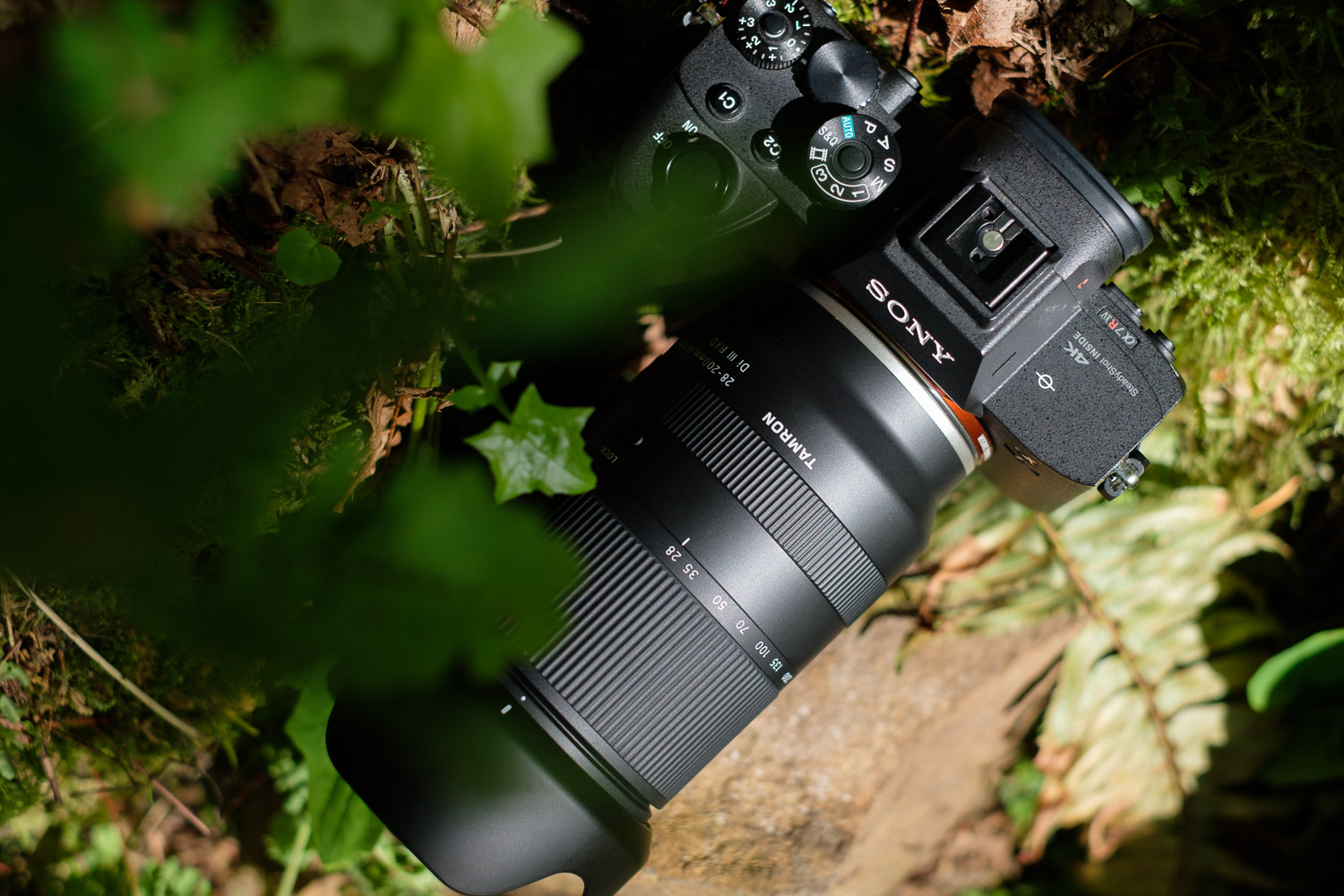The Function F is Continuous on the Closed Interval 28 and Has Values That Are Given in the Table

Tamron's 28-200mm f/2.8-5.6 superzoom beats expectations
"Small and lightweight, this superzoom is perfect for casual photography."
Pros
- Compact, lightweight
- Bright f/2.8 aperture (at wide end)
- Generally fast autofocus
- Premium fit and finish
Cons
- Severe vignetting
- Poor edge sharpness
I'm not a fan of superzooms. These "do-everything" lenses usually do everything poorly, and my expectations for the Tamron 28-200mm f/2.8-5.6, a full-frame lens for Sony E-mount cameras, were likewise low. At $729, it's a relatively affordable multi-purpose lens, and that's where I thought the story would end.
I was wrong.
I mostly shoot with primes – lenses that have a fixed focal length, and don't zoom at all. Primes are sharp, bright, and compact (well, not always), and can be optimized as such because of their single focal length. By contrast, the more zoom range you cram into one lens, typically the softer, darker, and larger it becomes.
But the Tamron 28-200mm surprised me. It is light and compact for a 7x zoom, while also being brighter than most, hitting an impressive f/2.8 at the wide end, 2/3 stop better than a majority of other similar lenses.
My expectations for sharpness, however, remained conservative. Mounting the lens to a 61-megapixel Sony A7R IV, provided for this review by Lensrentals, I knew intuitively that it couldn't live up to that camera's potential — and I was right.
The thing is, it didn't have to. While it's easy to question why someone would invest in an expensive full-frame camera only to outfit it with cheap glass, the truth is there are many reasons why we take pictures, and for most of us, capturing the greatest amount of detail is not the main one.

The Tamron 28-200mm isn't a professional-level lens, but it's also doesn't need to be. It's the perfect "uncle Bob" lens you can use as a guest at a wedding, much to the annoyance of the professional photographer hired to document the event. But I mean this genuinely. This is a lens for the way most people take pictures most of the time, and in that role, it excels. Even that aforementioned professional wedding photographer might want to take the lens out on her off days.
Design
At just 4.6 inches long (compressed at 28mm) and only about 20 ounces in weight, the Tamron 28-200mm won't make you feel overburdened. I carried it and the Sony A7R IV in my hand on a three-hour hike and never felt fatigued. I didn't even have a camera strap.
This is the Tamron's biggest strength. Full-frame cameras, even mirrorless ones, can balloon to unwieldy sizes when paired with some lenses, and fitting this much zoom range into such a mobile package is impressive.

The lens is also moisture-resistant, which I very much appreciated while taking pictures near the base of a waterfall.
About half of the outer lens barrel is dedicated to the zoom ring, which is wrapped in a grippy rubber that feels great in the hand. The zoom action is very smooth and lends a premium feel to the lens not often associated with the superzoom category. The focus-by-wire ring is a bit flimsier, but I doubt many people will be using manual focus, anyway.
A zoom lock is the sole switch on the lens, which can hold it at 28mm when not in use to prevent lens creep. Even if you forget to use it, there's plenty of resistance in the zoom that this shouldn't be a problem in normal use — I had to shake the lens fairly violently to get the zoom barrel to move at all.

Optically, we're looking at 18 elements in 14 groups, and Tamron lists "a series of specialized elements" designed to improve sharpness. I take this which a huge grain of salt as this really is not a stellar performer when it comes to image quality, but more on that later.
The aperture range is f/2.8 to f/16 at the wide end and f/5.6 to f/32 at the telephoto end. At 70mm, the maximum aperture is f/4, a full stop brighter than Sony's 24-240mm f/3.5-6.3 at the same focal length. This is another real advantage of the Tamron compared to other superzooms, as that extra light-gathering capacity can help keep your ISO down or your shutter speed up, reducing noise or preventing motion blur, respectively.
Autofocus and image quality
The 28-200mm uses Tamron's Rapid Extra-Silent Stepping Drive, or RXD, autofocus motor. In practice, I found the lens focused quickly and accurately the vast majority of the time, although it occasionally lagged just behind when my subject was moving toward me. In fairness, most of my testing was performed while hiking through a pretty dark forest. Even though it was the middle of the day, I was often shooting at ISO 3,200 or above, so I wasn't working with a ton of light. Focus performance would likely be even better in brighter conditions.
As for image quality, well, this is where the 28-200mm starts to fall behind. On the plus side, the f/2.8 aperture allows for a decent amount of depth of field control at the wide end, and the way the lens renders defocused areas is actually pretty nice as far as superzooms go. The telephoto compression at 200mm also makes for a decent portrait look, even if the aperture is only f/5.6. Subjectively, I don't hate it, but nor is it anything exciting.

It's not all good news, though. Objectively, the lens falls short in several ways. Vignetting is intense, and while it decreases at the telephoto end, so does overall light transmission. Shooting f/5.6 at 200mm looks to be about 1/3 stop darker than f/5.6 at 70mm. Gratefully though, at smaller apertures, transmission across the zoom range is essentially equal.
There is also some strange behavior when it comes to detail. At the wide end, sharpness falls off quite significantly from the center to the edges of the frame, but the edges do improve noticeably when you stop down to f/5.6. The center, however, doesn't seem to get much sharper. At the telephoto end, while detail is naturally more uniform across the frame, I didn't notice any benefit to stopping the lens down. F/5.6 and f/11 looked equally sharp — or equally not sharp.
Part of this probably has something to do with the camera. At 61 megapixels, the A7R IV is diffraction-limited somewhere around f/5.6 — so even if the lens was sharpening up at f/11, there's a chance I just couldn't see it. The A7R IV's is an incredibly unforgiving sensor, and I'm not surprised the Tamron 28-200mm doesn't ever look great on it under close inspection.
But this is a lens built for casual use in the real world, and unless you plan on making huge prints, I don't think you'll be dissatisfied with the quality. With in-camera lens corrections enabled, you probably won't even notice many of its shortcomings. The ability to capture a wide variety of shots with reliable autofocus from such a lightweight package is a significant advantage for the average customer, one that easily outweighs the imperfect optical performance.
Our take
One day, optical engineers will find a way to build a superzoom lens that doesn't sacrifice image quality. Today is not that day. If you're looking for a lens that can show off what your full-frame Sony camera can do, this is not it.
But in this case, that's OK.
The Tamron 28-200mm f/2.8-5.6 is not trying to be the one lens to rule them all. If your expensive Sony G Master lenses are what get you through the week, this Tamron is what you pull out on the weekend. It's the lens you take camping or pack into your carry-on for an international flight (when that's allowed again). It's the lens you choose when you're ready to stop worrying about megapixels, field curvature, and bokeh, and focus instead on making memories.
And for most of us, that's what photography is all about.
Is there a better alternative?
Sony makes a 24-240mm f/3.5-6.3 which, at $1,050, isn't that much more expensive and it gives you more range than the Tamron, but at the expense of a slower aperture. It is also larger and heavier, at 27.6 ounces, making it less suitable for activities like hiking.
What strikes me most about the Sony lens is the wider angle — the difference between 24mm and 28mm is bigger than you might think, but the extra 40mm on the telephoto end I don't personally find to be that useful. For most people, I don't expect either is worth giving up 2/3 stop of light and adding more bulk to your camera bag.
How long will it last?
The solid build quality should give this lens good longevity and, like most lenses, it should last many years. If you're looking at it as a first lens, however, you may quickly outgrow its limitations.
Should you buy it
Yes, if you want a flexible walk-around lens for a Sony mirrorless camera. Don't expect optical greatness, but the Tamron 28-200mm is perfect when you need a portable, one-lens solution for any casual photography environment.
Editors' Recommendations
- Lens teardown reveals how Canon made an affordable super-telephoto
- Sony's new ultra-wide full-frame lens is the first of its kind
- The $600 Panasonic Lumix S 20-60mm is a unique, affordable zoom
- What really determines your camera's resolution? We asked an expert
- Canon EOS R5 is everything the R isn't, thanks to stabilization, 8K, dual slots
Source: https://www.digitaltrends.com/camera-lens-reviews/tamron-28-200mm-f28-56-review/
0 Response to "The Function F is Continuous on the Closed Interval 28 and Has Values That Are Given in the Table"
Post a Comment